Zalmen Glauber
- Sculpture Image Gallery
- Bio
- Statement
- Contact
- Video
- Media
- Links Page
- Exhibits
- Search
- Login
- Share...Sculpture Image Gallery
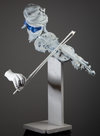
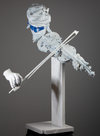
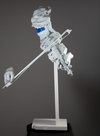
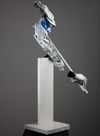




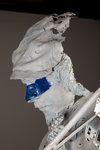 Fiddler of New York
Fiddler of New York
2018
Aqua resinFrom Fiddler on the Roof to the ubiquitous fiddler in the works of painter Marc Chagall to world-renowned musician Itzhak Perlman, the violin has long been associated with the Jewish people. What accounts for this connection? Some scholars have concluded that Jewish musicians were the ones responsible for the instrument. A further link between Judaism and the violin may lie in the Hassidic musical tradition. The violin appeals to the Jewish soul because of the intensity of its music. Without our traditions, our lives would be as shaky as, as... as a fiddler on the roof!"
The Fiddler of New York depicts a more modern and glitzier feel and finish. The same Jew the same look, Just a different time and a different place.
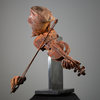
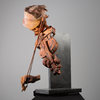
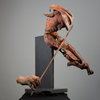
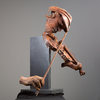




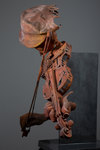 Fiddler of Kiev
Fiddler of Kiev
2017
Aqua resinFrom Fiddler on the Roof to the ubiquitous fiddler in the works of painter Marc Chagall to world-renowned musician Itzhak Perlman, the violin has long been associated with the Jewish people. What accounts for this connection? Some scholars have concluded that Jewish musicians were the ones responsible for the instrument. A further link between Judaism and the violin may lie in the Hassidic musical tradition. The violin appeals to the Jewish soul because of the intensity of its music. Without our traditions, our lives would be as shaky as, as... as a fiddler on the roof!"
The fiddler of Kiev, depicts a traditional Fiddler from the shtetl, with traditional hat and rust colors
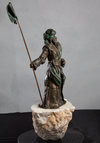
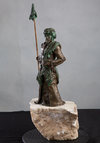
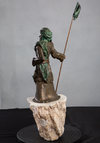
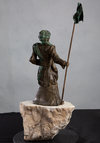
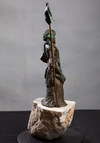 Reuben Of The 12 Tribes
Reuben Of The 12 Tribes
2016
Bronze
15 x 9 x 11 inchesThis exquisitely modeled sculpture depicts Reuben, the firstborn of the twelve tribes of Israel. The Bible highlights Reuben having a kind and thoughtful nature, collecting flowers for his mother and saving his brother Joseph’s life. This bronze piece, mounted on a stone base, is the first of a 12-part series depicting the personalities of Jacob’s children.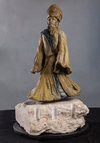
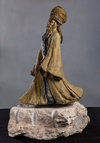
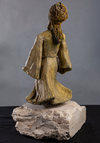
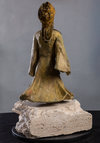 Levy Of The 12 Tribes
Levy Of The 12 Tribes
2016
Bronze
15x9x11"This majestic piece depicts the tribe of Levi, who was elevated to perform holy service, in the Tabernacle of the desert and in the Temple. Hence, it is a affirmative command for all Levites to be available and prepared for Temple Service, as stated in the Torah, "The Levites shall be for Me" (Numbers 18:14), indicating that the special relationship with the tribe of Levi is permanent. The prophet Jeremiah relates God's promise that there will always be Kohanim and Levites fit to serve: "As I will never renege on My covenant with day and night, so is my covenant with...the Levites, the Kohanim, My servants" (Jeremiah 33:21)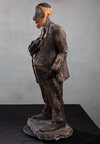
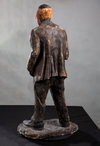
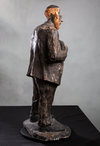
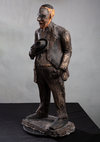 Hasid and Hat
Hasid and Hat
2015
Plaster, pigments,
29 x 13 x 7 inchesThis plaster piece, patinated with earthy pigments, depicts a Hasid in traditional garb. The side-curls worn, known as Payot, are based on the Biblical injunction against shaving the corners (pe'at) of one's head. The red hair connotes a fiery commitment to divinity even while navigating the rigors of modernity.
Kissing Tefillin
2017
Plaster, pigments,
29 x 11 x 9" inchesTefillin are a pair of black leather boxes containing Hebrew parchment scrolls. The Torah commands Jewish men to bind tefillin onto their head and upper arm every weekday, in fulfillment of the verse (Deut. 6:8), “You shall bind them as a sign upon your hand, and they shall be for a reminder between your eyes.” Tefillin are an incredibly powerful mitzvah and the experience of putting them on has changed many people’s lives. Cast in plaster and mounted on a stone base, Kissing Tefillin incorporates real, refurbished tefillin straps.
6 Million
2016
mixed medium
10 x 25 x 19" inches the base 52 x 27 x 19" inchesAuschwitz was a network of concentration and extermination camps built and operated by Nazi Germany in occupied Poland during World War II. The SS authorities introduced the practice of tattooing numbers to identify the bodies of registered prisoners who had died. This harrowing mixed media piece depicts the tattooing process and contains a real smoke system. The piece is dedicated to the artist’s grandmother, a Holocaust survivor.
Auto-de-fé
2017
Mixed medium
40 x 28 x 9" inchesThis brutally realistic piece evokes the inquisitional dungeons, where Jews were interrogated (occasionally under torture), and sentenced to a variety punishments ranging from terms of penitential service to imprisonment, as well as “relaxation,” that is, death. Of the dozens of expulsions directed against Jews throughout their history, Spain’s remains the most infamous. A plaster figure, battered almost beyond recognition, is stretched within a wooden frame that is decorated with drawings and prints from the period.
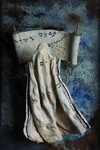
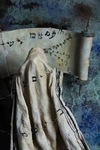
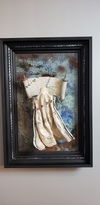
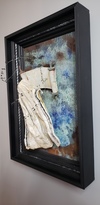 living word
living word
2016
Mixed medium
22x16x10"This majestic piece depicts a living Torah, with an actual prayer shawl containing the Torah latters floating and surrounding a vibrant Jewish sefer Torah. A Sefer Torah scroll is a handwritten copy of the Torah, the holiest book in Judaism. It must meet extremely strict standards of production. The Torah scroll is mainly used in the ritual of Torah reading during Jewish prayers. At other times, it is stored in the holiest spot within a synagogue, the Torah ark, which is usually an ornate curtained-off cabinet or section of the synagogue built along the wall that most closely faces Jerusalem, the direction Jews face when praying.
David Ben Maimon
2015
gypsum
19x12x15"While Jewish history has chronicled Moshe Maimonides, relatively little is known about his brother David. David was a merchant; with a success international jewel business, tragically died in 1170, in a shipwreck on his way to India. Among the treasures lost were letters between the Maimonides brothers. The piece depicts a plaster prayer shawl, from the shipwreck, the last remains of this great legacy.
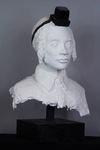 Mitzvah Tefilen
Mitzvah Tefilen
2012
gypsum
16x11x8"The manufacturing processes of both the boxes and the parchment scrolls of Teillin are intricate and governed by hundreds of detailed rules. Black leather straps are juxtaposed wit the light parchments inside is reminiscent of concepts within the Jewish mystical traditions can be seen depicted in this piece of teenage boy sculpted from plaster.Window To The Soul
2014
gypsum & wood
4x8x2"This piece depicts a home that is in decay yet the doorway remains strong, Judaism teaches that the body and soul are separate yet indivisible partners in human life. Rather than imprisoning or corrupting the soul, the body is a God-given tool for doing sacred work in the world. It requires protection, care, and respect, because it is holy. Without the body, the soul would be unable to do the holy, redemptive work of following the commandments. The doorway represents the future will inhabit that home and utilizes real twigs to depict a tree whose roots are strong.
Roman Columns Hillside
2015
gypsum
25x22x9"Plaster depiction of Roman Columns
is part of a series the chronicles
symbols of Jewish life in exile. These
columns enabled the ancient
Romans to build vast edifices with
the humblest materials, to build
bridges, aqueducts, sewers, amphitheatres,
and triumphal arches, as well as palaces.
Historians notes that many Roman buildings
may have been constructed utilizing
Jewish salves in harsh.Learning With Zeidy
2017
gypsum & paper
13x21x4"Ever since the Middle Ages, Jews have sweetened
a child’s first time learning the Hebrew alphabet
(often at the early age of three) with honey. The Midrash relates that before G-d gave the Torah to the Jewish people, he requested guarantors who would ensure that the people would indeed study Torah and fulfill the mitzvot. The Jewish people offered their own children. They promised that the children would study Torah and safeguard it for generations. And to this G-d agreed. The children are the ideal guarantors. In this poetic piece Glauber depicts Zeidy's aging hands teaching the next generation to fulfill this holy tradition.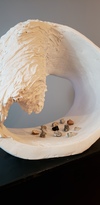
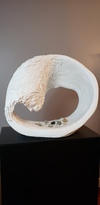
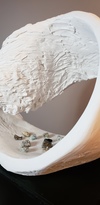 Parting Of The Sea
Parting Of The Sea
2016
gypsum & Semi Precious Stones
23x24x22"The Parting the Red Sea, is a finely crafted sculpture. A highly detailed work capturing the poetic majesty of this iconic Jewish story. The 12 stones represent the 12 tribes of Israel, of Jacob’s twelve sons. Each jewel was set into the High Priestly breastpiece and engraved with a tribe name.
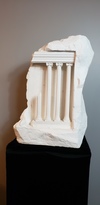
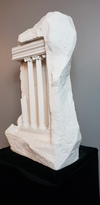
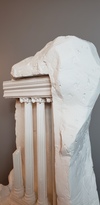
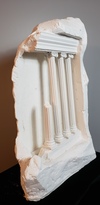 Roman Columns
Roman Columns
2015
gypsum
23x17x7"Plaster recreation of a Roman column. This type of architecture was very common in Ancient Rome and were used in many buildings. Columns originated from the Ancient Romans’ counterpart, the Ancient Greeks. Even though columns originated from Greece, the Romans suited them to their tastes and architectural liking. Roman columns were purely for decoration, unlike Greek columns that were used to support their buildings and temples. There were four types of columns used throughout the Ancient Roman Empire. These columns were: Doric, Ionic, Corinthian and Tuscan.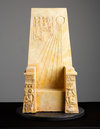
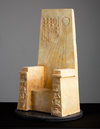
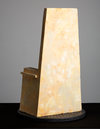
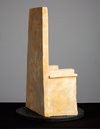
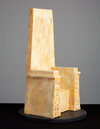 Throne Of Joseph
Throne Of Joseph
2015
Gypsum
19x10x6"Joseph was one of the twelve tribes of Israel, a son of Jacob and his wife Rachel. Known as “the righteous one,” he was favored by his father (who gave him a special colored coat) and sold by his brothers to Egypt, where he ultimately became ruler of the land, second only to King Pharaoh. Joseph ruled Egypt for a total of eighty years, until his death at the age of 110. Before his passing, he made his brothers promise to take his coffin along with them when they would eventually leave Egypt for the Promised Land. This magnificent throne piece depicts ancient hieroglyphics of the Egyptian as well as alludes to various dreams of Joseph.Footsteps Of Life
2017
gypsum
12x25x6"this poetic piece depicts relations between an elderly Man and the
Environment through the Symbolism of a Trees. Jewish tradition tells the story of an old man who was bent over a small fruit tree he was planting in the ground. He was approached by a passer-by who said to him, “Old man, come and greet the Messiah!” The old man said, “I’m planting a fruit tree.” “A fruit tree! You won’t live long enough to eat its fruit. Come, the Messiah is waiting.” The old man said once more, “Let me finish planting the fruit tree and then I’ll greet the Messiah.” The point of the story is about our hope for a better future, maybe for us but most definitely for our children. We plant for the future. It’s what we do, even if the fruit is something only our children and grandchildren will enjoy.Honey Fidel
2018
gypsum
23x9x4"Violin, part of a set of 18 complete with differing traditional Jewish hats, depicts the multiplicity that exists within Judaism. From Fiddler on the Roof to the ubiquitous fiddler in the works of painter Marc Chagall to world-renowned musician Itzhak Perlman, the violin has long been associated with the Jewish people. What accounts for this connection? Some scholars have concluded that Jewish musicians were the ones responsible for the instrument. A further link between Judaism and the violin may lie in the Hassidic musical tradition. The violin appeals to the Jewish soul because of the intensity of its music. Without our traditions, our lives would be as shaky as, as... as a fiddler on the roof!"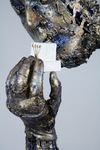
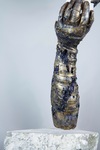
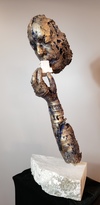
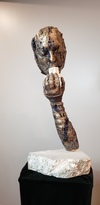
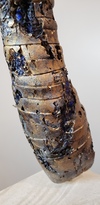
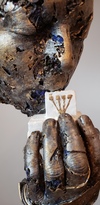
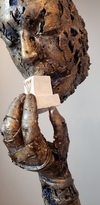 The Holy Tefiln
The Holy Tefiln
2017
gypsum
25x11x9"A companion piece to the 'kissing Teflin' the piece depicts a much
older withered man who has been beaten-down remains connected to his
spiritual center. And whilst be may be weathered his form remains
golden and the case box of his Tefiln white with gold lettering.
Unlike other books, which comes into existence through the act of
writing, the text of the Torah is script. The Talmud says that the
Torah given to Moses was written “in black fire on white fire,” it
again emphasizes the distinction between the language of the Torah,
which exists eternally.Praying At The Wailing Wall "I Am The Wailing Wall"
2014
Gypsum
9x12x2"The Kotel, is the most significant site in the world for the Jewish people,
representing the last remnant of our Holy Temple.
This collection of 19 versions of The Wall, depicts a cornucopia of Jewish places, peoples & maps, times throughout our 1900 years exile, and the resulting Diaspora.
This dispersion of Jews has fostered its own cultural nuances which the collection honors.
Praying At The Wailing Wall "America"
2018
Gypsum
9x12x2"America:
Only several thousand Jews lived in the US upon its establishment on July 4, 1776, most of them Marrano and people who were exiled or escaped from Spain in favor of colonies in North America. The great wave of immigration began in 1882. Czarist Russia, which was home to about half of the world's Jews, went through a failed industrial revolution and within 42 years, some two million Jews immigrated to the US from Ukraine, western Russia, Poland, Lithuania, Belarus and Romania. They made up 25% of the Jewish population in those countries, about 15% of the world's Jews, and 10 times the number of Jews who immigrated to the Land of Israel during that period.
Whilst many workplaces were blocked to the Jews due to an anti-Semitic campaign’s and most of them lived in crowded and filthy slums in New York – Brooklyn and the Lower East Side. Jewish immigrants, however,
emerged from poverty and made faster progress than any other group of immigrants. Making American Jews today one of the wealthiest ethnic groups in the universe. This piece is a testimony to this journey.Praying At The Wailing Wall "Bablon"
2018
Gypsum
9x12x2"Babylon:
applied pigments on gypsum,
the work is inspired by the blue and gold glazed hue that adorned that Babylon gate. The deep blue being reminiscent the semi-precious stone that was revered in antiquity due to its vibrancy.
By the middle of the Fourth Century, Christian persecution in Israel caused sages to immigrate to Babylonia. For the first time in nearly 800 years Torah scholarship was concentrated in one area and became were fixed in a formalized lexicon, forming the bulk of the Babylonian Talmud.
Praying At The Wailing Wall "Broken Vessels"
2018
Gypsum
9x12x2"Broken Vessels:
applied pigments on gypsum,
the piece has been literally broken by the artist
and reformed with golden glue in a process symbolic of the Kabbalistic concept known as, “The Shattering of the Vessels.” Our spiritual purpose is to gather the sparks of light contain in these primordial vessels, no matter where they are hidden. Throughout many physical and spiritual exiles the Jewish peoplehood have sought to release the holy sparks from the servitude of captivity safe in the knowledge our collective history is bound together with golden glue!Praying At The Wailing Wall "Gemara"
2018
Gypsum
9x12x2"Gemara (Talmud):
This splendid piece is comprised of transfer paper submerged into plaster. Evoking the composition of the Talmud, the central text of Rabbinic Judaism and the primary source of Jewish religious law and theology.
For centuries the Talmud has served as "the guide for the daily life" of Jews and refers to the collection of writings named specifically the Babylonian Talmud (Talmud Bavli), although there is also an earlier collection known as the Jerusalem Talmud (Talmud Yerushalmi.)
Praying At The Wailing Wall "Masada"
2018
Gypsum
9x12x2"Masada:
Masada (Hebrew for fortress) is a place of gaunt and majestic beauty that has become one of the Jewish people's greatest symbols as the place where the last Jewish stronghold against Roman invasion stood. Next to Jerusalem, it is the most popular destination of tourists visiting Israel.
applied metal on gypsum, then oxidized. the piece is inspired by the colors and aesthetics of the desert.
More than two thousand years have passed since the fall of the Masada fortress yet the regional climate and its remoteness have helped to preserve the remains of its extraordinary story.Praying At The Wailing Wall "Melting Pot"
2018
Gypsum
9x12x2"There are many sites steeped in history that may be felt in awe.
However, there is one place which even leaves one awe-struck. In the old city of Jerusalem, one walks in the footsteps of history and at the Western Wall (or Kotel). Many Jews—secular, religious, and everything in between—sings and dance hand-in-hand. This magnificent piece depicts the melting pot of colors and through the diversity of Diaspora forms a Jewish community.
Praying At The Wailing Wall "Rambam"
2019
Gypsum
9x12x2"Rabbi Moses (Moshe) ben Maimon (1135-1204), known by the acronym Rambam, was the most influential Jew of the Middle Ages. Whilst Rambam was famous for integrating philosophy and science within Judaism, his codification of Jewish law, the Mishneh Torah, became the standard practice. Glauber juxtaposes the academic blue hues with the regal Tallit depicting that everything comes from The Almighty.Praying At The Wailing Wall "Rashi"
2018
Gypsum
9x12x2"RASHI
applied print transfer on gypsum the piece is inspired by the unique architectural penmanship of Rabbi Solomon ben Isaac scholarly commentary. Rabbi Solomon ben Isaac (Shlomo Yitzhaki), known as Rashi (based on an acronym of his Hebrew initials), was born in Troyes, Champagne and is one of the most influential Jewish commentators in history.
Rashi script is a semi-cursive typeface for the Hebrew alphabet, the typeface (which was not used by Rashi himself) is based on 15th century Sephardic semi-cursive handwriting. The purpose was to distinguish the rabbinic commentary from the text itself for which a proper square typeface was used. The Rashi typeface is also traditionally used for printed Judaeo-Spanish.Praying At The Wailing Wall "Roman"
2018
Gypsum
9x12x2"Rome:
applied pigments on gypsum,
this vibrant piece is inspired by the colors of ancient Rome; purple, red and silver. The color of purple and its association with the Roman Emperors is due to vast expense of producing clothing made of such a color. This is juxtaposed with the common color of which red was produced by using a cheap dye and used for Roman clothing.
G‑d told Abraham that the Jewish people would be subjugated over the course of history by four kingdoms. The final subjugation, which immediately precedes the messianic age, will be under Rome.(Bereishit Raba 44:20) Our present exile is seen as an extension of the Roman subjugation, since culturally and legally western civilization shares the values and worldview of ancient Rome.
Praying At The Wailing Wall "12 tribes of Israel"
2018
Gypsum
9x12x2"The 12 Tribes of Israel:
The Shevatim
This geometric piece of varying properties reveal 12 golden boxed spaces representing the 12 tribes of Israel. Jacob had twelve sons. The offspring of each of these men became the twelve tribes (shevatim) of the nation of Israel. Although all the tribes are part of one nation, each tribe (shevet) has unique characteristics. From multiplicity becomes oneness.
Praying At The Wailing Wall "Lithunia"
2019
Gypsum
9x12x2"The Jews experienced various social and cultural
Characteristics while living amongst the nations.
Ashkenazim (Jews of German origin)
Then spreading out to Poland and Hungary, they are united by a shared sense of
spiritual destiny.
The European Jews experienced various social and cultural
characteristics, historically, the most fundamental difference was
between Ashkenazim (Jews of German origin) and Sephardim (descendants
of Jews expelled from Spain and Portugal.) Ashkenazim, who constituted
at least 90 percent of the Jews of Europe, were largely divided:
between Litvaks (Lithuania) and Hasidim (Hungary.) Whilst these groups
experiences different culture they are united by a shared sense of
spiritual destiny.
Praying At The Wailing Wall "Rabbi Yochanan Ben Zakkai"
2018
gypsum
9x12x2"Yochanan ben Zakkai:
Yochanan ben Zakkai was the youngest and most distinguished disciple of Rabbi Hillel. He has been called the "father of wisdom and the father of generations (of scholars)" because he ensured the continuation of Jewish scholarship after Jerusalem fell to Rome in 70 C.E.
According to tradition, Ben Zakkai was a pacifist in Jerusalem in 68 C.E. when the city was under siege by General Vespasian. Ben Zakki told Vespasian that he had had a vision that Vespasian would soon be emperor, and he asked Vespasian to set aside a place in Yavneh (near modern Rehovot) where he could start a small school and study Torah in peace. Vespasian promised that if the prophesy came true, he would grant ben Zakkai's request. Vespasian became Emperor within a year, and kept his word, allowing the school to be established after the war was over. The school ben Zakkai established at Yavneh became the center of Jewish learning for centuries and replaced Jerusalem as the seat of the Sanhedrin.
Loading...

































































































































